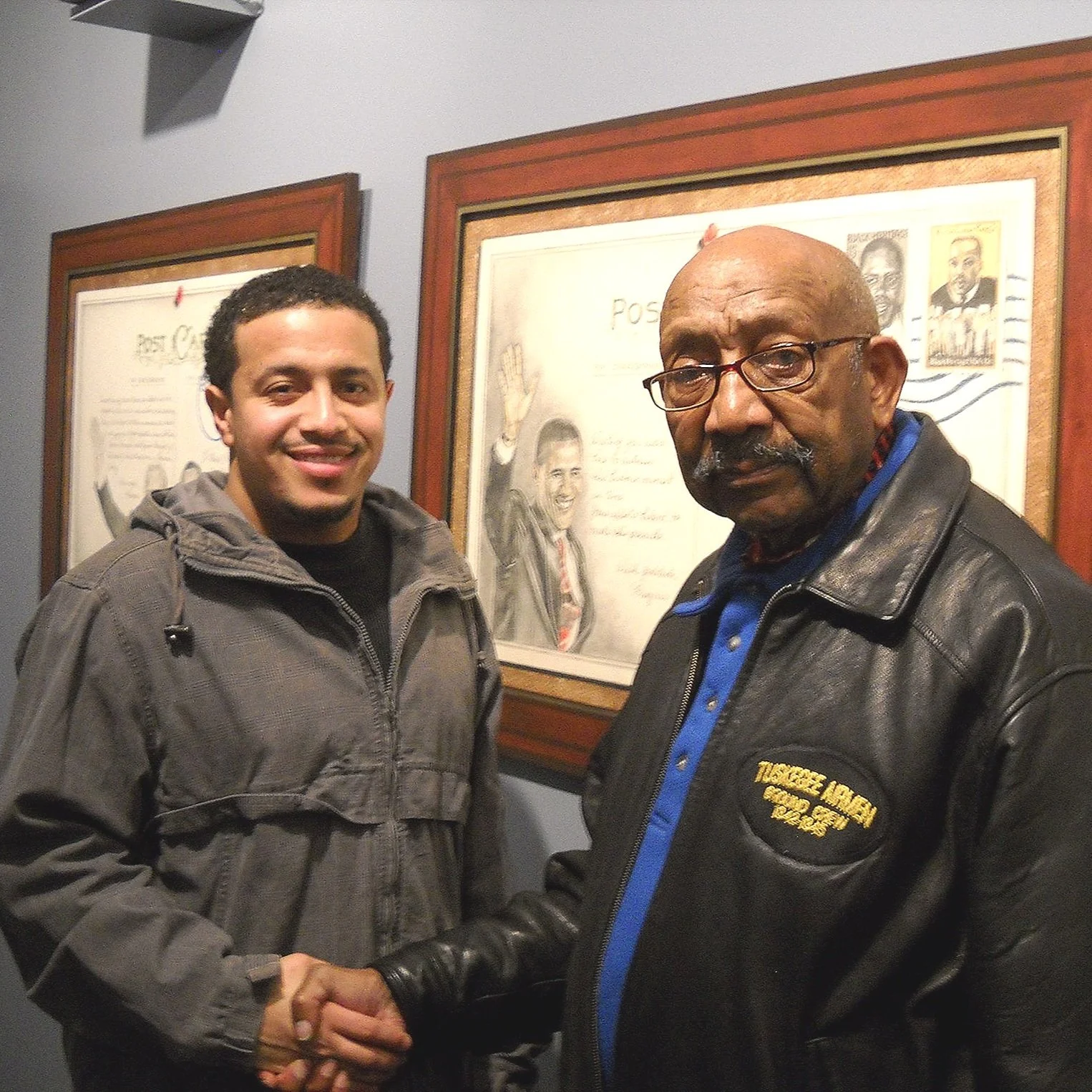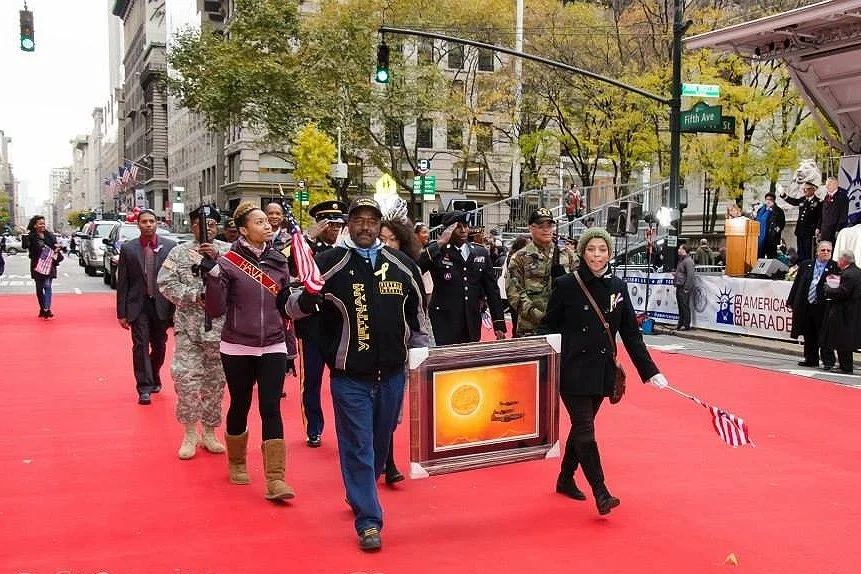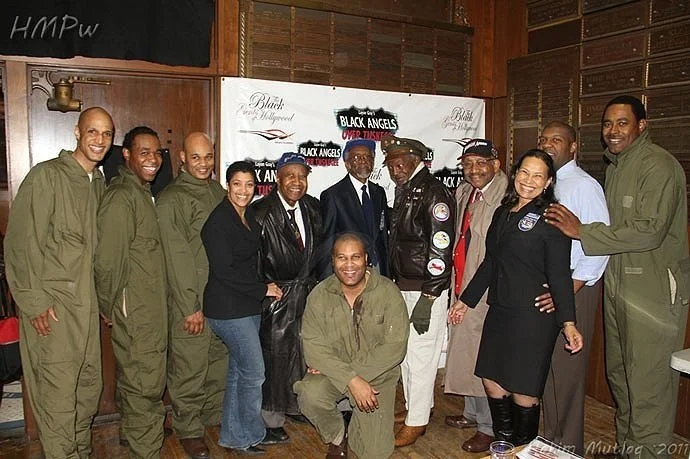Photo Credit: Glenda E. JonesTUSKEGEE AIRMEN
First all Black aerial combat unit
in World War II
Dabney N. Montgomery
Dabney N. Montgomery, pictured above with me and to the left with my son William Diaz, was a documented original Tuskegee Airman, a 2007 recipient of the Congressional Gold Medal, and was an active participant in the Civil Rights Movement of the 1960s, acting as a bodyguard for Martin Luther King Jr. during the Selma to Montgomery March of 1965.
“In 2011, I had the honor and pleasure of meeting and getting to know Dabney Montgomery at a New York Stock Exchange reception.”
Minerva Diaz
unveing of "tuskegee eclipse" at NYC annual luncheonIn 2011, as I entered the New York Stock Exchange Building on my way to a reception, an elderly gentleman stumbled in front of me. Instinctively, I reached out to steady him. With a smile, he introduced himself as Dabney and declared me his date for the evening. We entered the reception together, and I spent much of the evening in his company, captivated by his tales of WWII experiences and his role as Martin Luther King's bodyguard, as evidenced by his decorated bomber jacket.
During the event, a Black Lt General of the US Marine Corps asked me to introduce him to the Tuskegee Airmen. Though I was initially unfamiliar with them, I introduced him to Dabney, and the two engaged in conversation as if they were old friends. As I listened, I learned about the Tuskegee Airmen, the first Black fighter pilot unit in WWII, and witnessed the admiration between the men—a Black Lt General honoring a veteran who paved the way for his own position, and a legendary veteran beaming with pride at the progress made since WWII.
Dabney and I became friends, and he invited me to attend meetings held by the Tuskegee Airmen at LaGuardia Airport. Before I knew it, I found myself assisting them in promoting George Lucas' movie, Red Tails. And in 2012, at the White House screening of Red Tails, Dabney Montgomery presented President Barack Obama with prints from my “Postcards from Progress” series on my behalf.
In 2013, I received an invitation to their annual luncheon, where I unveiled my artwork titled "Tuskegee Eclipse." Following the unveiling, five Tuskegee Airmen, including my friend Dabney, graciously signed my work. Later that year, I was honored to march alongside them during the Veterans Day parade, paying tribute to the five Tuskegee Airmen pilots of Haitian descent.
Dr. Roscoe Brown was unable to attend the 2013 luncheon, but in 2014, I was invited to a symposium honoring Tuskegee Airman Percey Sutton. At the event, Dr. Roscoe Brown and former NYC Mayor Dinkins served as guest speakers. I had the privilege of being introduced to both gentlemen before the event, and afterward, Dr. Roscoe Brown added his signature to my work.
Dabney Montgomery passed away at the age of 93 on September 3, 2016. It was truly a privilege to have known him. In honor of his remarkable legacy, on April 21, 2018, the corner of West 136th St. and Adam Clayton Powell, Jr. Boulevard was renamed Tuskegee Airman Dabney N. Montgomery Place.
Narrated by Minerva Diaz
DOTA dabney montgomery, grounds crewDOTA William Johnson, pilotDOTA Lt. Col. (Ret) Clayton F.Lawrence, BombardierDOTA Lt. Col. (Ret) Floyd Carter, pilotPhoto Credit: Glenda E. JonesDOTA Wilfred R. Defour, grounds crewdavid dinkins and dota dr. roscoe brownveterans day parade 2013Tuskegee airmen and cast from Black Angels over tuskegeePhoto Credit: Hakim MutlaqPhoto Credit: Glenda E. JonesDabney's 90th bdayDabney Montgomery was a dedicated activist during the Civil Rights Movement and marched alongside Reverend Dr. Martin Luther King, Jr. during the historic 50+ mile march from Selma to Montgomery, Alabama, from March 21-25, 1965. Serving as one of Dr. King’s bodyguards, he exhibited remarkable courage and commitment to the cause.
During the march, Mr. Montgomery removed the heels from his shoes and carefully preserved them, along with the necktie he wore and an address book containing Reverend King’s name and Atlanta, GA address, in a wooden shadowbox. In August 2015, the Montgomery family generously gifted this significant artifact to the National Museum of African American History and Culture (NMAAHC) of the Smithsonian Institution in Washington, D.C. The NMAAHC Collections Committee approved the gift in January 2016, ensuring its place in the permanent collection and exhibition of the Civil Rights Movement.
in the permanant collection at the National Museum of African American History and CultureDabney montgomery street naming in harlem nyGeorge lucus's "redtail" screening event @ white housephoto credit: Pete SouzaThe term "Tuskegee Airmen" was coined on May 15, 1955, with the publication of "The Tuskegee Airmen--The Story of the Negro in the U.S. Air Force" by Charles E. Francis. Prior to this, they were referred to as the "Red Tails."
Contrary to some reports, the Tuskegee Airmen did experience losses of several U.S. bombers to enemy fire during escort missions. However, it's important to highlight that they maintained one of the best records for bomber escort units, with notably fewer losses compared to other American fighter units. The "Red Tails," as they were known at the time, were highly sought after for escort service by U.S. bomber crews due to their impressive track record of minimal losses.
President George W. Bush and the U.S. Congress collectively awarded the Tuskegee Airmen the Congressional Gold Medal (CGM) on March 29, 2007, six decades after they completed their World War II mission and returned home to a country that discriminated against them because they were black.
This prestigious honor was bestowed upon the 300 airmen and widows who attended the ceremony, representing the estimated 16,000 to 19,000 individuals who participated in the "Tuskegee Experience," known as documented original Tuskegee Airmen (DOTA). Following the ceremony, the CGM was displayed at the Smithsonian Institution's National Air and Space Museum, where it remains today.
Content from Tuskegee University














